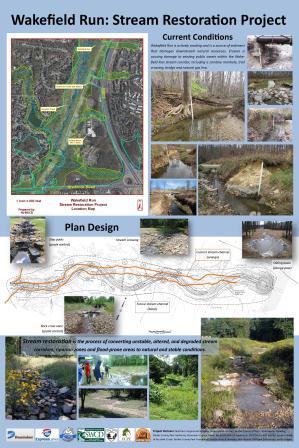 Fairfax County is fortunate to have hundreds of miles of stream, many of which are protected on park or county land. However, development in the streams' watersheds has caused damage. The Soil and Water Conservation District helped pioneer natural channel design stream restoration locally, which is now used across the county to prevent pollution loads downstream. These techniques may be used on a smaller scale by residential homeowners and communities to restore and stabilize streams.
Fairfax County is fortunate to have hundreds of miles of stream, many of which are protected on park or county land. However, development in the streams' watersheds has caused damage. The Soil and Water Conservation District helped pioneer natural channel design stream restoration locally, which is now used across the county to prevent pollution loads downstream. These techniques may be used on a smaller scale by residential homeowners and communities to restore and stabilize streams.
The Crook Branch stream restoration at Mantua Elementary School is a great example of how these projects support stream health. You can learn more about this project in this short video.
Land development through urbanization plays a significant role in changing the hydrologic balance in our watersheds. Impervious surfaces such as rooftops, asphalt roads, and concrete replace the trees, shrubs, groundcover, and soil that retain and filter stormwater. The net outcome of increased imperviousness is a significant increase in surface runoff.
Streams, the main recipients of increased runoff, make room in the channel by eroding the banks and bed. The result is a wider and deeper channel. As the stream erodes vertically and laterally, sediment and attached nutrients wash downstream. Even in a healthy, stable stream, some erosion and deposition can occur during major storm events. However, when runoff in a watershed increases dramatically, erosion and deposition become excessive.
NVSWCD promotes the rehabilitation of streams through restoration or stabilization techniques. Watershed planning in advance of development can prevent stream problems. However, in the absence of appropriate and consistent planning, streams are likely to degrade. In Fairfax County, many streams have suffered as a result of upstream development. The District works with County, state, and federal agencies and homeowner associations to identify streams with economically feasible rehabilitation potential. Once streams are identified, the District collaborates with these agencies to do the restoration or stabilization work. The District provides project coordination, grant writing and support, technical advice, and publicity for the projects.
 In 2013-4, the Wakefield Run Stream Restoration, facilitated by the Soil and Water Conservation District, was completed. Click on the image on the left to see the full-size project poster.
In 2013-4, the Wakefield Run Stream Restoration, facilitated by the Soil and Water Conservation District, was completed. Click on the image on the left to see the full-size project poster.
In summer 2007, a NVSWCD-facilitated partnership restored a 775-foot segment of Little Pimmit Run in McLean. Homeowners adjacent to the stream initiated the primarily privately-funded project. Steep-walled and undercut stream banks and degraded riparian habitat characterized the stream prior to the project. Rapid erosion (~2 ft/yr) and bank instability threatened the Fairfax County parkland adjacent to the stream along with the backyards of several homeowners. The project’s designers, including conservation district staff, applied the principles of natural channel design, an approach that takes into account naturally-occurring stream processes such as flooding and sediment transport as well as stream ecology. The design they developed provides habitat, protects property, discourages erosion, protects water quality and facilitates recreation along and within Little Pimmit Run.
To learn more about how stream restoration works, see Understanding Stream Restoration

